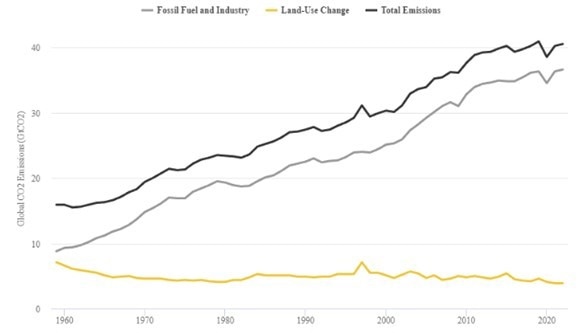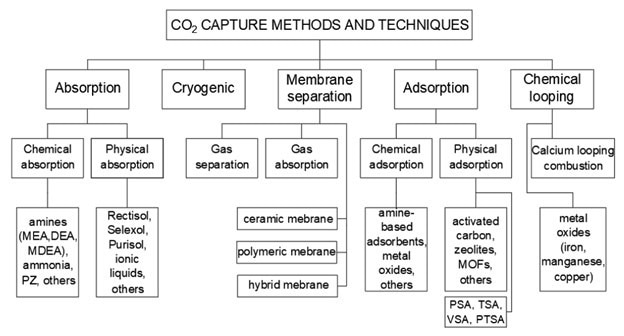The carbon capture and sequestration (CCS) process is currently the point of focus for the private sector and governments worldwide. The United States government is significantly investing in this technology to reduce carbon dioxide and greenhouse gas emissions. Carbon America, a company focusing on carbon capture and sequestration technologies located in Arvada, Colorado, US, is a frontrunner in managing all essential aspects of a carbon capture project, including transportation, logistics, and optimized techniques.

Image Credit: GLF Media/Shutterstock.com
The State of Carbon Emissions in Recent Years
In 2019, around 37 billion metric tons of fossil CO2 were released into the atmosphere, double the amount released in 1990. A report was published by the Global Carbon Project in 2022 regarding global carbon dioxide emissions estimates.
The Global Carbon Project estimated that global CO2 emissions, including those from terrestrial use and fossil fuels, would remain reasonably high at 40.5 GtCO2 in 2022, although these numbers were below their 2019 peak of 40.9 GtCO2.
Global CO2 levels reached a new high of 417.2 parts per million (ppm), 2.5 ppm higher than in 2021.

Global CO2 emissions (fossils and land use). Image Credit: Carbon Brief
Industrial Trend of Carbon Capture and Sequestration Technology
According to Fortune Business Insights, the worldwide carbon capture and sequestration market will expand at a CAGR of 19.5% between 2021 and 2028, reaching USD 7 billion.
In 2020, the industry was estimated at $1.96 billion. The market expansion is attributable to the rising collaboration amongst industry titans to commercialize CCS technology by constructing large-scale manufacturing facilities.
The market is segmented by capture source into petrochemical, gas processing, fertilizer, and energy production.
In 2019, the natural gas processing category accounted for 47.3% of the CCS market share. This expansion is due to the availability of high-capacity manufacturing facilities and the rising energy demand.
Due to substantial expenditures in research and development efforts and several high-capacity carbon capture and sequestration facilities, North America will likely lead the worldwide market in 2020 with a total size of USD 1.42 billion.
Funding for Commercial and Industrial Projects
In June 2021, the U.S. Department of Energy (DoE) confirmed a USD 12 million government grant to assist six research and development (R&D) initiatives supporting direct air capture (DAC) technology to create new instruments for efficiently gathering CO2 from the environment.
In August 2022, the U.S. Department of Energy's (DOE) Office of Fossil Energy and Carbon Management (FECM) officially confirmed financial support of more than $31 million for ten projects aimed at developing carbon capture technology capable of capturing at least 95% of carbon dioxide (CO2) emissions from coal-fired power plants, and commercial plants.
In addition, FECM has invested an aggregate of $76 million in 22 research and innovation projects, front-end engineering design, and engineering-scale projects at natural power generation commercial setups, waste-to-energy, and manufacturing sites as part of the DOE's overall endeavors to decarbonize the existing infrastructure and accomplish the emissions targets.
Commercial and Industrial Challenges
The carbon capture and sequestration (CCS) sector has many obstacles that must be overcome to ensure its broad implementation and profitability.
Even though the technology to capture and store post-combustion emissions has been developed for a long time, the commercial cost is quite expensive.
According to the International Energy Agency (IEA), the costs of capturing and preserving CO2 can be up to three times that of lowering emissions through other techniques, such as renewable or sustainable sources. Government assistance to tilt the economics favoring CCUS is essential for encouraging its use and implementation.
Another obstacle is the lack of storage facilities. For CCS to succeed, CO2 must be deposited in subterranean structures, such as exhausted oil and gas reserves and mineral deposits. However, the accessibility of these sorts of storage locations is restricted, and the long-term storage potential of these sites is not fully understood. In addition, there are worries over the possibility of leakage and the effect on groundwater supplies.
Alternative Policy Regimens for Promoting Carbon Capture Technology
The U.S. Government Accountability Office outlined seven policy alternatives that might assist in addressing these obstacles or enhancing the advantages of CCS technologies. Regulators, among whom are Congress, federal departments, local governments, state governments, research, educational institutes, and the industrial and commercial sectors, may take one of the policy alternatives.
|
Policy Option
|
Opportunities
|
Considerations
|
|
Research, development, and demonstration
Authorities might increase support for sustained financing of R&D and industrial-scale deployments concurrently.
|
- Research and development might cut costs, address problems, improve quality, and promote developing technology.
- Demonstrations might cut costs and prove the practicality of carbon capture by fostering experiential learning.
|
- Different perspectives on research and development agendas exist among various sectors.
- Large-scale demonstrations need vigilant monitoring.
|
|
Technology-neutral specifications
Policymakers might promote the development, acceptance, and implementation of technology-neutral standards.
|
- Could encourage creating or using items with the most significant CO2 advantages.
- Could encourage manufacturing in the United States
|
- Standards development is a resource-intensive and time-consuming process
- Without standardized life cycle evaluation, assessing the CO2 benefits of various goods may be challenging.
|
|
Guidelines for standardized life cycle evaluation
To confirm the advantages of CO2-based goods, policymakers might assist in developing and implementing life cycle assessment standards.
|
- Could increase the precision of evaluations between different CO2 usage processes or products.
|
- The procedures of standards creation and life cycle evaluation are resource-intensive and time-consuming.
- It may be difficult to coordinate the efforts of several parties to produce consistent life cycle evaluation criteria.
|
|
Structure for accessibility
At the national level, policymakers might assist in creating legislative or administrative frameworks to regulate geologic CO2 storage.
|
- Transparency in legislative or regulatory matters might enable the installation of CO2 storage facilities.
- Pore-space unitization procedures might minimize the time and expense required to negotiate storage property access.
|
- Individual proprietors may dispute the loss of certain property rights due to pore space unitization.
- CCS projects may need collaboration across state lines.
|
|
Strategic placement
Legislators might help with the strategic placement of CCUS installations.
|
- Could reduce economic and administrative obstacles to CCUS growth.
- Carbon capture and usage businesses may boost expansion if infrastructural accessibility improves.
|
- Certain geographical places that are naturally more suitable for CCUS may profit more from infrastructural expenditures than others.
- Some populations may not desire CCUS facilities for a wide range of reasons, including concerns about environmental and safety issues.
|
|
Tweaking CCS incentive programs
Policymakers might tweak preexisting rewards to make CCUS projects more accessible.
|
- Could expand the number or types of facilities employing CCUS.
- This could stimulate the development of innovative technologies to lower capture costs.
|
- Changing tax incentives might decrease state tax income or increase fossil fuel use.
- Modifying market-based techniques may be vulnerable to carbon price unpredictability.
|
|
Public outreach
Authorities might promote and support effective public participation concerning CCUS deployment.
|
- A more profound comprehension of public opinion may influence community participation and decision-making.
- Could increase regional support and decrease delays.
|
- Effective public outreach and awareness initiatives may be resource-intensive.
- Additional endeavors may necessitate new money or the reallocation of current resources.
|
The Recent Boom in the Carbon Capture Industry
Despite several obstacles, various CCS projects are now in development worldwide. According to the Global CCS Institute, 22 large-scale CCS plants are in operation, with an additional 15 under construction or advanced research stages. These initiatives can capture and store approximately 40 million tons of CO2 annually, comparable to eliminating over eight million automobiles.
Carbon America - A Pioneer of Carbon Capture and Sequestration
Carbon America has revolutionized the carbon capture and sequestration industry by optimizing all aspects of a project.
Carbon America prefers an optimized technology from various capture technology options for every specific carbon capture project. Its ability to economically administer transport and logistics, enhancement, supervision, and assumption of the liabilities of stable geologic sequestration facilities is a significant advantage.
Carbon America handles all the crucial enabling operations, including tax assets, authorizing, structured finance, sequestration site layout, and compensation certification.
Overview of Carbon Capture and Sequestration Techniques by Carbon America
Pre-combustion, post-combustion, and oxy-combustion carbon capture are the three methods of CO2 sequestration. Before combustion, carbon is captured by pre-combustion (through fuel gasification with oxygen, e.g., integrated IGCC coal gasification technology).
Carbon capture occurs after the burning process (capturing CO2 from flue gas, e.g., using chemical absorption, physical adsorption, membrane separation, or using a chemical loop).
Oxy-combustion carbon capture occurs following the complete combustion in an oxidizing atmosphere by isolating CO2 produced during the oxy-combustion process, such as with an oxygen gas turbine. Before burning, nitrogen can be extracted from the air to create an oxygen-rich environment.

Methods and techniques for CO2 capture. Image Credit: Madejski et al.
Projects by Carbon America to Promote the CCS Industry
Carbon America is playing its part in promoting the CCS industry by launching several products in different parts of the US. These projects could generate revenue, increase funding for the CCS technology development, and raise public awareness of this ever-flourishing domain commercially.
Carbon America aims to develop a CCS facility to sustainably store 95% of Nebraska’s ethanol plant CO2 emissions underground. A total of 175,000 tons of CO2 will be captured and stored annually.
The strategy is to construct specialized equipment to absorb CO2 from ethanol production and send it via a novel carbon dioxide pipeline to a subterranean geologic sequestration location near the facility.
Federal Class VI and California Air Resource Board Low Carbon Fuel Standard Permanency criteria are carefully met at the sequestration site.
Carbon America also assists Colorado in testing a novel carbon capture system at two ethanol facilities. The method proposed for the Colorado facilities would catch and store virtually all the carbon dioxide emitted when corn is processed, estimated at around 350,000 tons per year.
In short, CCS technology is significantly progressing, owing to the interest of governments worldwide. The interest of almost every industrial sector in carbon capture technologies is a forerunner of its rapid commercialization.
The passion of Carbon America for carbon capture ensures that it would play a key role in developing optimized solutions and bringing novelty to carbon capture and sequestration technology.
References and Further Reading
Businesswire, 2022. Carbon America to Construct, Own and Operate the First Two Commercial Carbon Capture and Sequestration Projects in Colorado. [Online] Available at: https://www.businesswire.com/news/home/20220512005336/en/Carbon-America-to-Construct-Own-and-Operate-the-First-Two-Commercial-Carbon-Capture-and-Sequestration-Projects-in-Colorado
Businesswire, 2022. Carbon America to Launch Nebraska’s First Commercial Carbon Capture and Sequestration Project. [Online] Available at: https://www.businesswire.com/news/home/20221004005399/en/Carbon-America-to-Launch-Nebraska%E2%80%99s-First-Commercial-Carbon-Capture-and-Sequestration-Project
Carbon America, 2023. Solutions. [Online] Available at: https://www.carbonamerica.com/solutions/ccs101
Madejski P et al. (2022). Methods and Techniques for CO2 Capture: Review of Potential Solutions and Applications in Modern Energy Technologies. Energies. 15(3). 887. Available at: https://doi.org/10.3390/en15030887
Fortune Business Insight, 2022. Carbon Capture and Sequestration Market Size to Grow Worth USD 7.00 Billion. [Online] Available at: https://www.globenewswire.com/en/news-release/2022/09/28/2524008/0/en/Carbon-Capture-and-Sequestration-Market-Size-to-Grow-Worth-USD-7-00-Billion-at-a-CAGR-of-19-5-for-2021-2028-Fortune-Business-Insights.html
Fortune Business Insights, 2022. Carbon Capture And Sequestration Market Size, Share & Covid 19 Impact Analysis, Forecast 2021-2028. [Online] Available at: https://www.fortunebusinessinsights.com/industry-reports/carbon-capture-and-sequestration-market-100819
Hausfather, Z. & Friedlingstein, F., 2022. Analysis: Global CO2 emissions from fossil fuels hits record high in 2022. [Online] Available at: https://www.weforum.org/agenda/2022/11/global-co2-emissions-fossil-fuels-hit-record-2022/
National Oceanic and Atmospheric Administration, 2022. Global atmospheric carbon dioxide levels continue to rise. [Online] Available at: https://research.noaa.gov/article/ArtMID/587/ArticleID/2914/No-sign-of-significant-decrease-in-global-CO2-emissions
Oil and Gas IQ, 2022. 3 Key Challenges For The Deployment Of CCUS. [Online] Available at: https://www.oilandgasiq.com/decarbonization/articles/3-key-challenges-for-the-deployment-of-ccus
Tilbury, J., 2022. Four challenges carbon capture and storage must overcome. [Online] Available at: https://www.linkedin.com/pulse/four-challenges-carbon-capture-storage-must-overcome-james-tilbury/?trk=pulse-article_more-articles_related-content-card
U.S. Government Accountability Office, 2022. Decarbonization: Status, Challenges, and Policy Options for Carbon Capture, Utilization, and Storage GAO-22-105274. [Online] Available at: https://www.gao.gov/products/gao-22-105274
Disclaimer: The views expressed here are those of the author expressed in their private capacity and do not necessarily represent the views of AZoM.com Limited T/A AZoNetwork the owner and operator of this website. This disclaimer forms part of the Terms and conditions of use of this website.